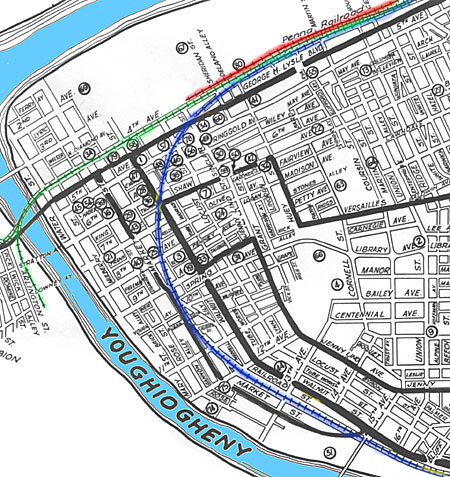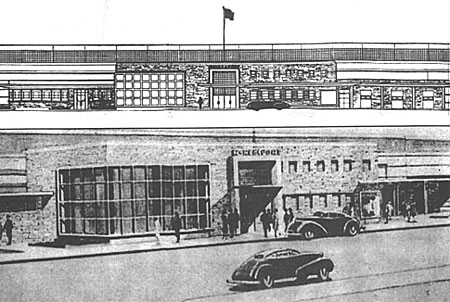
Category: default || By jt3y
I was asked last week, "Where were the old railroad tracks that ran through town located? Who owned them and when and why were they removed?"
Well, that reminded me that I forgot about a very important anniversary in Our Fair City's history. May 6 marked 35 years since the last Baltimore & Ohio train ran through the middle of Downtown. Starting that day, trains were detoured via the Pittsburgh & Lake Erie Railroad at Versailles, and the tracks that bisected Downtown were torn up. Since this is the last day of May, it seems appropriate to mark the 35th anniversary today.
I wrote a long screed several years ago about this very topic, but briefly stated, the Pittsburgh & Connellsville Railroad arrived in Our Fair City in the 1850s, running along what was then the far outskirts of the Borough of McKeesport. The P&C became part of the Baltimore & Ohio Railroad. Unfortunately, before the 19th century was over, the city had grown up and over the B&O tracks, and by the middle of the 20th, the tracks had become a major nuisance.
There were 28 grade crossings in the city in 1945. Among the most aggravating were the ones at the corner of Walnut at Sixth and on Fifth Avenue near Locust; according to an engineering study, Walnut was blocked for up to three hours daily, while Fifth was blocked for up to four hours per day. Office workers and shoppers frequently tried to crawl over, under, or between stopped trains, risking life and limb.
Here's a map of Downtown, showing the location of the tracks. The B&O is outlined in blue. The Pittsburgh & Lake Erie (which ran up the middle of Fourth Avenue, and was also a nuisance) is highlighted in green, while the Pennsylvania's spur line from Duquesne is outlined in red. The B&O's passenger station was on the north side of Fifth Avenue between Locust and Sinclair.

There were a variety of schemes proposed for rerouting the B&O, and I'll be posting a larger article about that in the Tube City Online history pages in a few days. (The railroad itself proposed a tunnel running underneath Downtown from roughly near the current McKeesport-Duquesne Bridge to the 15th Avenue Bridge. Other proposals included a massive cut through present-day White Oak and North Huntingdon Township.)
What's less well-known is that there was also a scheme to erect a "union station" in McKeesport that would have served both the B&O and P&LE (which offered some commuter train service to McKeesport through the '50s) as well as the post office and Railway Express Agency (a sort-of predecessor to today's UPS and Federal Express).

"McKeesport Union Station" was contigent on the B&O tracks being elevated and rerouted through town, and would have been located along Lysle Boulevard --- near, I suspect, the current location of the Port Authority's bus terminal and former train station.
Naturally, it was never built, which in the grand scheme of things is probably a good thing. Those cities that built modern, efficient railroad terminals after World War II wound up with expensive, empty white elephants once the railroads decided they wanted out of the passenger business in 1971. McKeesport Union Station likely would have languished for a few years as a commuter terminal before being closed when Port Authority killed off its passenger train service. As it is, we have more than our share of empty buildings already, thank-you-very-much.
Speaking of which: I see that the Masonic Temple is for sale now, too. It's currently assessed at $156,000, according to the county's website. The listed owner is the Masonic Temple Association of McKeesport. A search of the Pennsylvania Grand Lodge website shows that at least two Masonic organizations are still using the Temple for meetings --- Alliquippa Lodge No. 375 and Youghiogheny Lodge No. 583.
Too many fraternal organizations have had to close over the past 20 years (people just don't join clubs and lodges any more). I hope the decision to sell the Masonic Temple in McKeesport isn't a portent of some trouble; the city long had a very active and vibrant group of Masonic organizations. Maybe it's just a sign that the commercial real estate market has picked up.
...
P.S. There was no Almanac yesterday, on account of me being too busy on Sunday. Your indulgence is appreciated.
One minor item in ID’ing the railroads on the map. I believe that what is noted as the Pennsylvania RR is/was the Union Railroad, the glorified switching line for U.S. Steel. I presume that with the disappearance of the Tube, that trackage in no longer is service.
deane m. - May 31, 2005
That line is indeed operated by the Union RR today, but I believe it was originally a PRR line. It was much busier when National Tube was still operating, but Camp Hill still provides CSX and the Union with a fair amount of tonnage.
Wade (URL) - May 31, 2005
My tall friend is correct, I believe, on both counts. The through-truss bridge that the Union now uses was originally a PRR bridge, and the Pennsy had a freight station in McKeesport at the corner of Fourth Avenue and Huey Street until the 1960s. You could also buy a PRR train ticket for many years to “McKeesport,” but they dumped you in South Duquesne and you had to walk across the McKeesport-Duquesne Bridge or take the streetcar.
Webmaster (URL) - June 01, 2005
To comment on any story at Tube City Almanac, email tubecitytiger@gmail.com, send a tweet to www.twitter.com/tubecityonline, visit our Facebook page, or write to Tube City Almanac, P.O. Box 94, McKeesport, PA 15134.